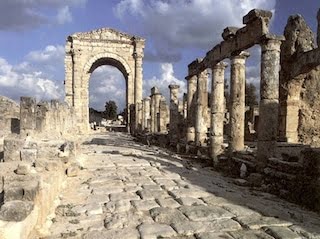

“Not that which goeth into the mouth defileth a man; but that which cometh out of the mouth, this defileth a man” (Matt 15:11).
I find this very interesting; we are talking about fabulous and wealthy city in 600 B.C., over 2,600 years ago. Pompeii also may be the most important archaeological site in the world, and also one of the largest, in terms of coherent, contiguous ruins.
We are unable to duplicate the Great Egyptian Pyramids, what about Pompeii? Can we duplicate it?
What was the water like in the Roman Empire? Tomorrow we’ll look at the…
Matthew 15
What Defiles a Man
1 Then came to Jesus scribes and Pharisees, which were of Jerusalem, saying,
2 Why do thy disciples transgress the tradition of the elders? for they wash not their hands when they eat bread.
“The tradition of the elders” – after the Babylonian captivity, the Jewish rabbis began to make meticulous rules and regulations governing the daily life of the people. These were interpretations and applications of the law of Moses, handed down from generation to generation.
In Jesus’ day this “tradition of the elders’ was in oral form. It was not until 200 c. A.D. that it was put into writing in the Mishnah (a part of the Talmud, the Jewish Bible.
3 But he answered and said unto them, Why do ye also transgress the commandment of God by your tradition?
4 For God commanded, saying, Honor thy father and mother: and, He that curseth father or mother, let him die the death.
5 But ye say, Whosoever shall say to his father or his mother, It is a gift, by whatsoever thou mightest be profited by me;
6 And honor not his father or his mother, he shall be free. Thus have ye made the commandment of God of none effect by your tradition.

The Mishnah essentially records those debates of the post-Temple sages from 70-2 A.D. (called the Tannaim) and is considered the first major work of “Rabbinical Judaism.”
The Jews never believed in Jesus, but the Islamic faith/Judaism wasn’t evil in the beginning, but it is now. As Jesus said: “He that is not with me is against me… (Matt 12:30).
7 Ye hypocrites, well did Esaias prophesy of you, saying,
8 This people draweth nigh unto me with their mouth, and honoureth me with their lips; but their heart is far from me.
9 But in vain they do worship me, teaching for doctrines the commandments of men.
10 And he called the multitude, and said unto them, Hear, and understand:
11 Not that which goeth into the mouth defileth a man; but that which cometh out of the mouth, this defileth a man.
12 Then came his disciples, and said unto him, Knowest thou that the Pharisees were offended, after they heard this saying?
13 But he answered and said, Every plant, which my heavenly Father hath not planted, shall be rooted up.
14 Let them alone: they be blind leaders of the blind. And if the blind lead the blind, both shall fall into the ditch.
15 Then answered Peter and said unto him, Declare unto us this parable.
16 And Jesus said, Are ye also yet without understanding?

17 Do not ye yet understand, that whatsoever entereth in at the mouth goeth into the belly, and is cast out into the draught?
18 But those things which proceed out of the mouth come forth from the heart; and they defile the man.
19 For out of the heart proceed evil thoughts, murders, adulteries, fornications, thefts, false witness, blasphemies:
20 These are the things which defile a man: but to eat with unwashen hands defileth not a man.
21 Then Jesus went thence, and departed into the coasts of Tyre and Sidon.
“Tyre” – About 25 miles north of Tyre.
22 And, behold, a woman of Canaan came out of the same coasts, and cried unto him, saying, Have mercy on me, O Lord, thou Son of David; my daughter is grievously vexed with a devil.
“Canaan” – a term found many times in the Old Testament but only here in the New Testament. In New Testament times there was no country known as Canaan. Some think this was the Semitic manner of referring to the people of Phoenicia at this time. Mark says the woman was “a Greek a Syrophenician” (Mk 7:26).
23 But he answered her not a word. And his disciples came and besought him, saying, Send her away; for she crieth after us.
 24 But he answered and said, I am not sent but unto the lost sheep of the house of Israel.
24 But he answered and said, I am not sent but unto the lost sheep of the house of Israel.
25 Then came she and worshipped him, saying, Lord, help me.
26 But he answered and said, It is not meet to take the children’s bread, and to cast it to dogs.
“Children’s” – “The lost sheep of the house of Israel” (v. 24).
“Dogs” – the Greek says “little dogs,” meaning a pet dog in the home, and Jesus’ point was that the gospel was to be given first to Jews. The woman understood Jesus’ implication and was willing to settle for “crumbs.” Jesus rewarded her faith (v. 28).
27 And she said, Truth, Lord: yet the dogs eat of the crumbs which fall from their masters’ table.
28 Then Jesus answered and said unto her, O woman, great is thy faith: be it unto thee even as thou wilt. And her daughter was made whole from that very hour.
29 And Jesus departed from thence, and came nigh unto the sea of Galilee; and went up into a mountain, and sat down there.
30 And great multitudes came unto him, having with them those that were lame, blind, dumb, maimed, and many others, and cast them down at Jesus’ feet; and he healed them:
31 Insomuch that the multitude wondered, when they saw the dumb to speak, the maimed to be whole, the lame to walk, and the blind to see: and they glorified the God of Israel.

32 Then Jesus called his disciples unto him, and said, I have compassion on the multitude, because they continue with me now three days, and have nothing to eat: and I will not send them away fasting, lest they faint in the way.
33 And his disciples say unto him, Whence should we have so much bread in the wilderness, as to fill so great a multitude?
34 And Jesus saith unto them, How many loaves have ye? And they said, Seven, and a few little fishes.
35 And he commanded the multitude to sit down on the ground.
36 And he took the seven loaves and the fishes, and gave thanks, and brake them, and gave to his disciples, and the disciples to the multitude.

37 And they did all eat, and were filled: and they took up of the broken meat that was left seven baskets full.
The feeding of the 5,000 is recorded in all four Gospels, but the feeding of the 4,000 is only in Matthew and Mark. The 12 baskets mentioned in the feeding of the 5,000 were possibly for the 12 apostles. Some think Jesus gave the extra food to the little boy. The seven baskets mentioned here were possibly larger.
38 And they that did eat were four thousand men, beside women and children.
39 And he sent away the multitude, and took ship, and came into the coasts of Magdala.
“Magdala” – the home of Mary Magdalene. Mk 8:10 has “Dalmanutha.”
The Villas of Pompeii
Pompeii and nearby Herculaneum, both buried by the 79 A.D. eruption of Mount Vesuvius, were popular resorts for wealthy Romans, who built villas along the Bay of Naples where they could enjoy the vistas and ocean breezes.

Roman villas such as the one diagrammed to the left here had an atrium at the entrance. An opening in the roof of the atrium allowed sunlight to enter on fair days. In foul weather, rain filled a pool beneath the sunlight.
Beyond the atrium lay a courtyard called the peristyle, containing a garden where residents could sit, stroll, or dine. Living rooms and bedrooms were tastefully furnished and beautifully decorated with frescoes and mosaics.
Visitorsa to Pompeii today can view the remains of such estates, including the Villa of Mysteries, so called for frescoes depicting a mysterious ritual. Among the figures portrayed there is Dionysus, the Greek god of wine, rapture, and fertility, whose devotees included women, called maenads.
The frescoes show women participating in an initiation rite of some kind. Brides may have undergone the ritual before marriage to seek fertility.
The gracious villas of Pompeii reflect the wealth that prominent Romans accumulated as their empire expanded. Some prospered through trade, which flourished when the Mediterranean Sea became, in effect, a Roman lake.
Others grew by amassing prizes of war, including slaves conquered lands, who toiled for their owners fields, workshops, or mines.
…aqueducts in the Roman Empire.
Visits: 0
